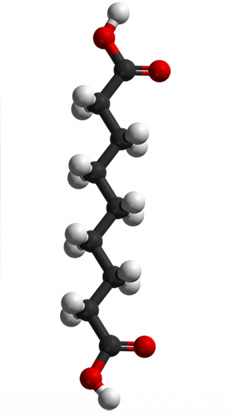







Azelaic acid molecule
Introduction
Azelaic acid (1,7-heptanedicarboxyilic acid, AZA) is a naturally occurring non-toxic straight chain, saturated dicarboxylic acid derived from Pityrosporum ovale, the organism responsible for pityriasis versicolor. Azelaic acid appears to selectively influence the mechanism of hyperactive and abnormal melanocytes, but minimally influences normal skin pigmentation, freckles, nevi and senile lentigenes.
The depigmenting activity of azelaic acid appears to be mediated by an antiproliferative and cytotoxic effect on melanocytes by potent inhibition of thioredoxin reductase, an enzyme involved in mitochondrial oxidoreductase activation and DNA synthesis.
The compound is also able to bind amino and carboxyl groups and may prevent the interaction of tyrosine in the active site of tyrosinase and thus function as a competitive and reversible inhibitor. Its lightening effect appears to be selective and most apparent in highly active melanocytes, with minimal effects in normally pigmented skin.
Formulations
Although azelaic acid was initially prescribed for the treatment of acne, it has been successfully used in the treatment of lentigines, rosacea, and postinflammatory hyperpigmentation. Available formulations include a 15% gel, typically used in the treatment of rosacea, or a 20% cream that is commonly used for acne vulgaris and melasma.
Studies
Although not all authors are in agreement with the therapeutic efficacy of azelaic acid, it has been reported to be effective in treatment of melasma and acne. A 24 week multicenter, controlled, double blind clinical trial of 329 women compared the efficacy of a 20% azelaic acid cream to a 4% HQ cream in treating melasma. The authors reported no significant difference between the results where 65% of the patients treated with azelaic acid were reported to achieve good to excellent results compared to 73% of HQ treated patients. 20% azelaic acid seems to be well tolerated in treated patients with no systemic side effects, but some local cutaneous irritation, a burning sensation, mild erythema, scaling and pruritus that subsided 2 to 4 weeks post treatment.
In a 6-month study on 132 Asian women with melasma, a mean 4 years of treatment with azelaic acid caused both a greater lightening of pigmented lesions and a reduction in lesion size. In another study, azelaic acid applied at concentrations of 15% or 20% twice daily for 3 to 12 months produced clinical and histological resolution in facial lentigo maligna and was successful in treating rosacea, solar keratosis and hyperpigmentation associated with burns and herpes labialis.
In a randomized, double-blind, vehicle-controlled trial of 52 patients (Fitzpatrick skin types IV–VI) with facial hyperpigmentation including PIH and melasma to determine the safety and efficacy of 20% AA cream patients treated with azelaic acid showed greater decreases in pigmentary intensity after 24 weeks of treatment versus vehicle as measured by the investigator's subjective scale (P=0.021) and chromometric analysis (P<0.039). Side effects were mild and transient. Multiple other studies have also shown the safety and efficacy of azelaic acid in skin of color for the treatment of melasma.
Safety
Azelaic acid is generally well tolerated and can be used for extended periods. Its most frequent side effects include transient erythema and cutaneous irritation characterized by scaling, itching and burning, which generally resolve after 2–4 weeks of application.
>
>
>
>
>
>
>
>
>
>
>
>
>
>
>
>
>
>
>
>
>
>
>
>
>
>
>
>
>
>
>
>
>
>
>
>
>
>
>
>
>
>
>
>
>
>
>
>
>
>
>
TOP 20
Hydroquinone
Monobenzyl Ether of Hydroquinone
Azelaic Acid
Kojic Acid
Arbutin
Retinoids
Mequinol
Niacinamide
Soy
Vitamin C
Corticosteroids
Licorice
Hydroxystilbene
Aloesin
Glutathione
Glycolic Acid
N Acetyl Glucosamine
Gentisic Acid
Green Tea
Melatonin
SKIN WHITENING AGENTS A-Z
a-Hydroxyacids
Aloesin
Alpha Tocopherol and Alpha Tocopherol Ferulate
Arbutin
Azelaic Acid
Centaureidin and Methylophiopogonanone B
Gallic Acid and Derivatives
Gingko
Ginseng
Glutathione
Glycolic Acid
Green Tea
Hesperidin
Hydroquinone
Hydroxycinnamic Acid and Derivatives
Hydroxystilbene
Kojic Acid
Licorice
Linoleic Acid
Magnesium Ascorbyl Phosphate
Melatonin
Mequinol
Monobenzyl Ether of Hydroquinone
Mulberry
N Acetyl Glucosamine
N-Acetyl-4-S-Cysteminylphenol
Niacinamide
Retinoids
Salicylic Acid
Soy
Vitamin C

<< Previous: Arbutin
Next: Centaureidin and Methylophiopogonanone B >>